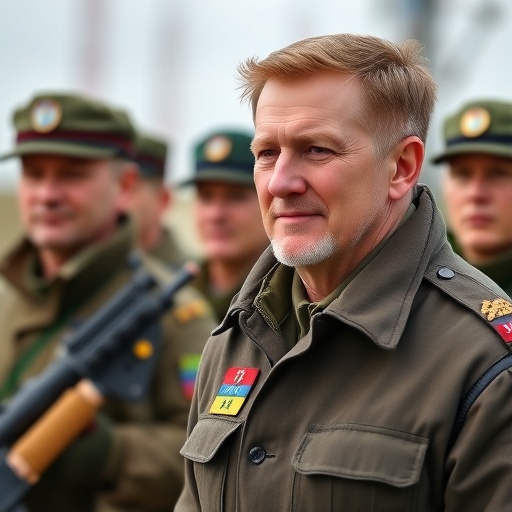Allied nations Vow to Eliminate Russian Oil and Gas from Global Markets, Ramp Up Ukraine Military Aid Under Starmer’s Leadership
In a bold move that could reshape global energy dynamics, Allied nations gathered in London have pledged to systematically remove Russian oil and gas from international markets while bolstering military support for Ukraine. Led by UK Prime Minister Keir Starmer, the summit marks a unified front against Russia’s energy leverage amid the ongoing conflict, promising accelerated sanctions and alternative energy sourcing to wean the world off Moscow’s grip.
- London Summit Forges Ironclad Alliance Against Russian Energy Exports
- Decoding the Blueprint: How Allied Nations Plan to Purge Russian Oil and Gas
- Ukraine’s Lifeline: Surging Military Aid Amid Energy Crackdown
- Market Tremors: Economic Ripples from Booting Russian Energy
- Path Forward: Sustaining Momentum in the Fight for Energy Sovereignty
The announcement, delivered on the final day of the high-level talks, comes at a critical juncture as winter approaches and Europe’s energy vulnerabilities remain stark. Starmer, addressing a room of diplomats from over 40 countries, declared, “We stand together not just in words, but in decisive action to starve Russia’s war machine of the funds it relies on.” This commitment builds on previous G7 efforts but introduces concrete timelines and mechanisms, signaling a potential end to Russia’s dominance in the global energy trade, which accounts for about 10% of worldwide oil supplies and 17% of gas before the 2022 invasion escalated sanctions.
The summit’s outcomes are expected to impact energy prices, supply chains, and geopolitical alliances, with immediate reactions from markets showing a slight dip in Brent crude futures as investors anticipate reduced Russian exports. As Allied nations coordinate their response, the focus shifts to implementation, with experts warning of short-term volatility but long-term stability through diversified energy sources.
London Summit Forges Ironclad Alliance Against Russian Energy Exports
The two-day summit at Lancaster House in London brought together leaders from the European Union, NATO allies, and key Indo-Pacific partners, all under the stewardship of Keir Starmer. Hosted by the UK, the event was framed as a “strategic pivot” away from dependency on Russian oil and gas, with discussions centering on Ukraine’s defense needs amid Russia’s relentless advances in the east.
Starmer opened the proceedings with a stark assessment: “Russia’s weaponization of energy has prolonged suffering in Ukraine and threatened our collective security. Today, we commit to a full divorce from their markets.” Delegates from Germany, France, the US, and Japan echoed this sentiment, agreeing on a phased elimination plan. The agreement outlines three pillars: enhanced sanctions enforcement, investment in alternative suppliers like Norway and Qatar, and technical aid to Ukraine for energy independence.
According to summit documents leaked to the press, the allied nations aim to reduce Russian energy imports to zero within 18 months for oil and 24 months for gas, barring any humanitarian exemptions. This timeline is ambitious, considering that pre-war, Europe imported 40% of its gas from Russia via pipelines like Nord Stream, now disrupted. To mitigate risks, the pact includes a $50 billion fund for renewable energy transitions and LNG infrastructure upgrades across member states.
Security was a parallel track, with pledges to increase military aid to Ukraine by 25% over the next year. This includes advanced air defense systems, artillery shells, and training programs. US President Joe Biden, represented by Secretary of State Antony Blinken, highlighted the synergy: “By cutting off Russian revenues, we weaken their battlefield capabilities and strengthen Ukraine‘s resolve.”
Decoding the Blueprint: How Allied Nations Plan to Purge Russian Oil and Gas
At the heart of the London accord is a detailed blueprint for excising Russian oil and gas from global circulation. The plan leverages existing mechanisms like the EU’s REPowerEU initiative and expands them internationally. For oil, allied nations will enforce a global price cap at $60 per barrel, stricter than the current G7 cap of $60, with secondary sanctions on non-compliant buyers such as India and China.
Gas elimination focuses on pipeline shutdowns and LNG rerouting. Russia currently supplies 155 billion cubic meters annually to Europe, but post-invasion flows have halved. The summit committed to filling the gap with 50 billion cubic meters of additional US and Australian LNG by 2025. “This isn’t just about energy; it’s economic warfare,” stated EU Commission President Ursula von der Leyen in a post-summit briefing.
Statistics underscore the urgency: Russian energy exports generated $383 billion in 2022 alone, funding 40% of its federal budget and sustaining the war in Ukraine. By targeting this revenue stream, allied nations estimate a potential 30% drop in Moscow’s war chest. Implementation will involve a new oversight body, the International Energy Sanctions Taskforce (IEST), headquartered in London, to monitor compliance and investigate evasion tactics like shadow fleets of oil tankers.
Challenges abound, however. Analysts from the International Energy Agency (IEA) warn that abrupt cuts could spike global prices by 15-20%, exacerbating inflation in vulnerable economies. To counter this, the plan incorporates subsidies for low-income households and incentives for green tech adoption. Keir Starmer emphasized diplomacy: “We’ll engage non-aligned nations to join this effort, offering trade benefits in return for shunning Russian supplies.”
- Key Targets: Ban on Russian crude to EU ports by Q2 2025.
- Gas Phase-Out: Complete halt of Siberian pipeline flows by end of 2026.
- Enforcement: Joint naval patrols in key shipping lanes to intercept shadow tankers.
Ukraine’s Lifeline: Surging Military Aid Amid Energy Crackdown
Parallel to the energy purge, the summit unveiled unprecedented military commitments to Ukraine, framing it as essential to counter Russia’s aggression. Keir Starmer announced a UK-led coalition to deliver 1,000 additional tanks and 500,000 artillery rounds by spring, building on the £2.3 billion already pledged this year.
Allied nations collectively promised $100 billion in aid over two years, including F-16 fighter jets from the Netherlands and Denmark, and long-range missiles from the US. Ukrainian President Volodymyr Zelenskyy, joining virtually, praised the move: “This support, combined with isolating Russian oil and gas, will turn the tide. It’s a message to Putin that his empire of fear is crumbling.”
The aid package addresses Ukraine‘s ammunition shortages, which have hampered counteroffensives. NATO estimates Russia produces 3 million shells annually, outpacing Ukraine’s 1 million. To bridge this, the alliance will ramp up joint production facilities in Poland and Romania, aiming for 2.5 million shells by 2025. Training programs for 50,000 Ukrainian troops will also expand, focusing on asymmetric warfare tactics.
Contextually, this escalation responds to recent Russian gains in Donetsk, where Moscow has captured 300 square kilometers since summer. Intelligence shared at the summit revealed Russia’s reliance on energy revenues to import drone components from Iran and North Korea, underscoring the dual impact of the pledges.
- Immediate Deliveries: 200 Leopard tanks from Germany arriving next month.
- Tech Transfers: Cyber defense tools to protect Ukraine’s grid from Russian sabotage.
- Humanitarian Tie-In: $10 billion for rebuilding energy infrastructure hit by strikes.
Market Tremors: Economic Ripples from Booting Russian Energy
The pledge to remove Russian oil and gas sent immediate shockwaves through global markets. On the day of the announcement, Russia’s Urals crude traded at a $15 discount to Brent, but futures indicated tightening supplies could push prices to $90 per barrel by year-end. Energy stocks in Europe rose 3%, while Russian firms like Gazprom saw a 5% plunge in after-hours trading.
Economists predict varied impacts: For allied nations, short-term inflation hikes of 2-3% in energy costs, but long-term savings from renewables. The IEA forecasts that full implementation could save Europe $200 billion annually in import bills by 2030. In Ukraine, the aid influx is projected to boost GDP by 5% through stabilized fronts and reconstruction.
Non-Western perspectives add complexity. India, a major buyer of discounted Russian oil, expressed concerns over supply disruptions, potentially leading to bilateral talks. China, reliant on Russian gas via Power of Siberia, might accelerate deals with Middle Eastern suppliers. “This is a high-stakes game,” noted Bloomberg analyst Elena Petrova. “Allied unity could force Russia to the negotiating table, but at the cost of global economic friction.”
Keir Starmer‘s government anticipates domestic benefits, with new North Sea drilling licenses to offset any gaps. Broader implications include accelerated climate goals, as divesting from fossil fuels aligns with COP28 pledges.
Path Forward: Sustaining Momentum in the Fight for Energy Sovereignty
As the ink dries on the London accords, allied nations face the test of execution. Follow-up meetings are scheduled for Brussels in December to refine enforcement, with Keir Starmer tasked with rallying G20 holdouts. For Ukraine, the military surge offers hope for reclaiming territories, potentially shifting negotiations toward a just peace.
Looking ahead, experts foresee a multipolar energy landscape: Increased US LNG dominance, African gas booms, and hydrogen breakthroughs. Yet, risks persist—Russian retaliation via hybrid threats or alliances with adversaries. The summit’s success hinges on sustained political will, as Starmer warned: “This pledge is our firewall against aggression; we must defend it vigilantly.”
In the coming months, quarterly progress reports will track reductions in Russian oil and gas flows, with milestones tied to aid disbursements. If realized, this could not only aid Ukraine but redefine global energy security for generations, proving that collective action trumps isolationist impulses.










